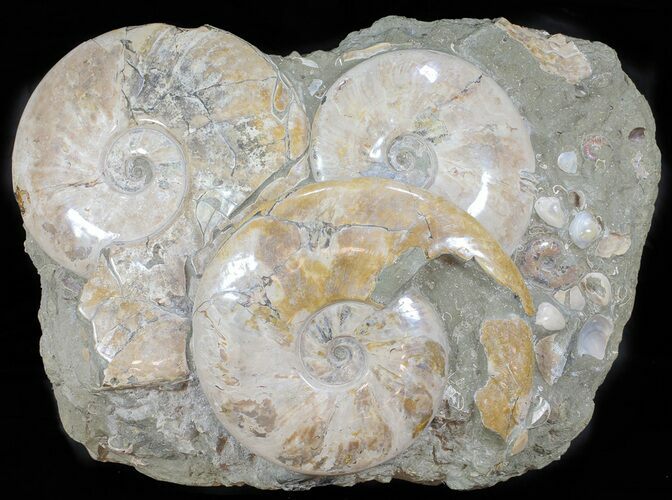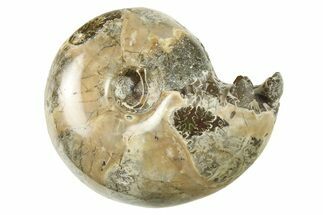This Specimen has been sold.
Giant, 23" Ammonite Fossil Cluster From Madagascar
Due to the size and weight of this piece it will be shipped on a pallet or in a crate via freight. Our website cannot automatically calculate freight shipping costs, so these costs will be calculated and billed after purchase. Please contact us prior to purchase if you need a shipping quote.
This is a cluster of large, polished ammonite fossils still embedded in the rock in which they were found. The largest ammonite measures 13" wide. Many other fossils including clams and gastropods can also be seen in the rock. The ammonites are Cretaceous (Albian Stage) in age or approximately 110 million years old and are quarried in the Mahajanga Province of Madagascar. The entire piece is 23" wide, 16.5" tall, and the base has been cut flat so that it displays well on a hard surface. This is a heavy piece weighing approximately 130 lbs.
About Ammonites
Ammonites were ancient marine cephalopods, similar to today's squids and octopuses, but with a defining feature: their distinctive, tightly coiled spiral shells. These shells, resembling those of modern nautiluses, served as both a protective home and a buoyancy aid, allowing ammonites to navigate the prehistoric seas with ease. First emerging around 240 million years ago in the Triassic Period, ammonites thrived for over 175 million years, adapting through numerous forms and sizes. As predatory creatures, they likely fed on smaller marine organisms, using their tentacles to capture prey. However, their long reign came to an end 65 million years ago at the close of the Cretaceous, coinciding with the mass extinction event that also eliminated the dinosaurs.
Ammonites were ancient marine cephalopods, similar to today's squids and octopuses, but with a defining feature: their distinctive, tightly coiled spiral shells. These shells, resembling those of modern nautiluses, served as both a protective home and a buoyancy aid, allowing ammonites to navigate the prehistoric seas with ease. First emerging around 240 million years ago in the Triassic Period, ammonites thrived for over 175 million years, adapting through numerous forms and sizes. As predatory creatures, they likely fed on smaller marine organisms, using their tentacles to capture prey. However, their long reign came to an end 65 million years ago at the close of the Cretaceous, coinciding with the mass extinction event that also eliminated the dinosaurs.
SPECIES
Cleoniceras sp.
LOCATION
Ambatolafia, Mahajanga Province, Madagascar
SIZE
23" Wide, 16.5" Tall, 8" Deep
CATEGORY
SUB CATEGORY
ITEM
#59728
We guarantee the authenticity of all of our specimens.
 Reviews
Reviews














